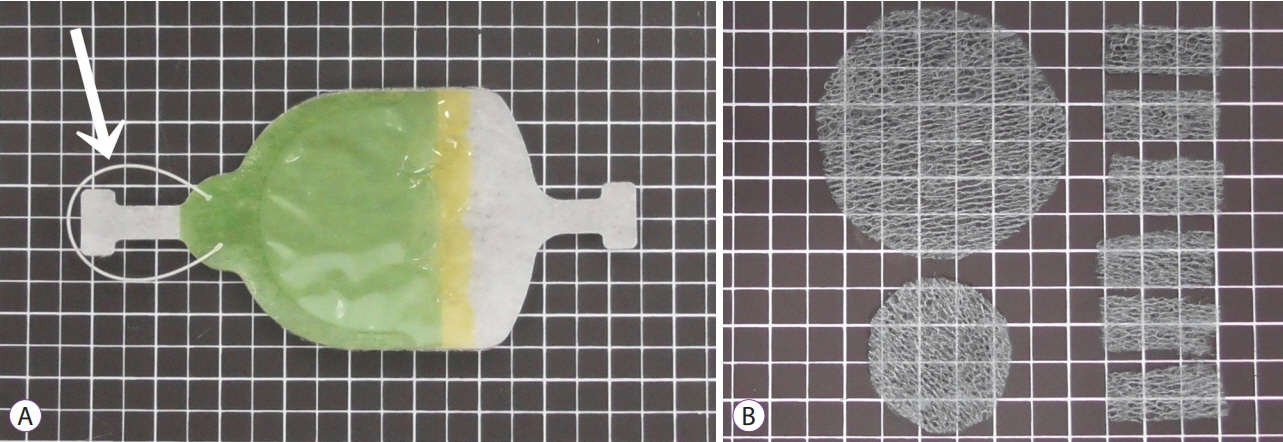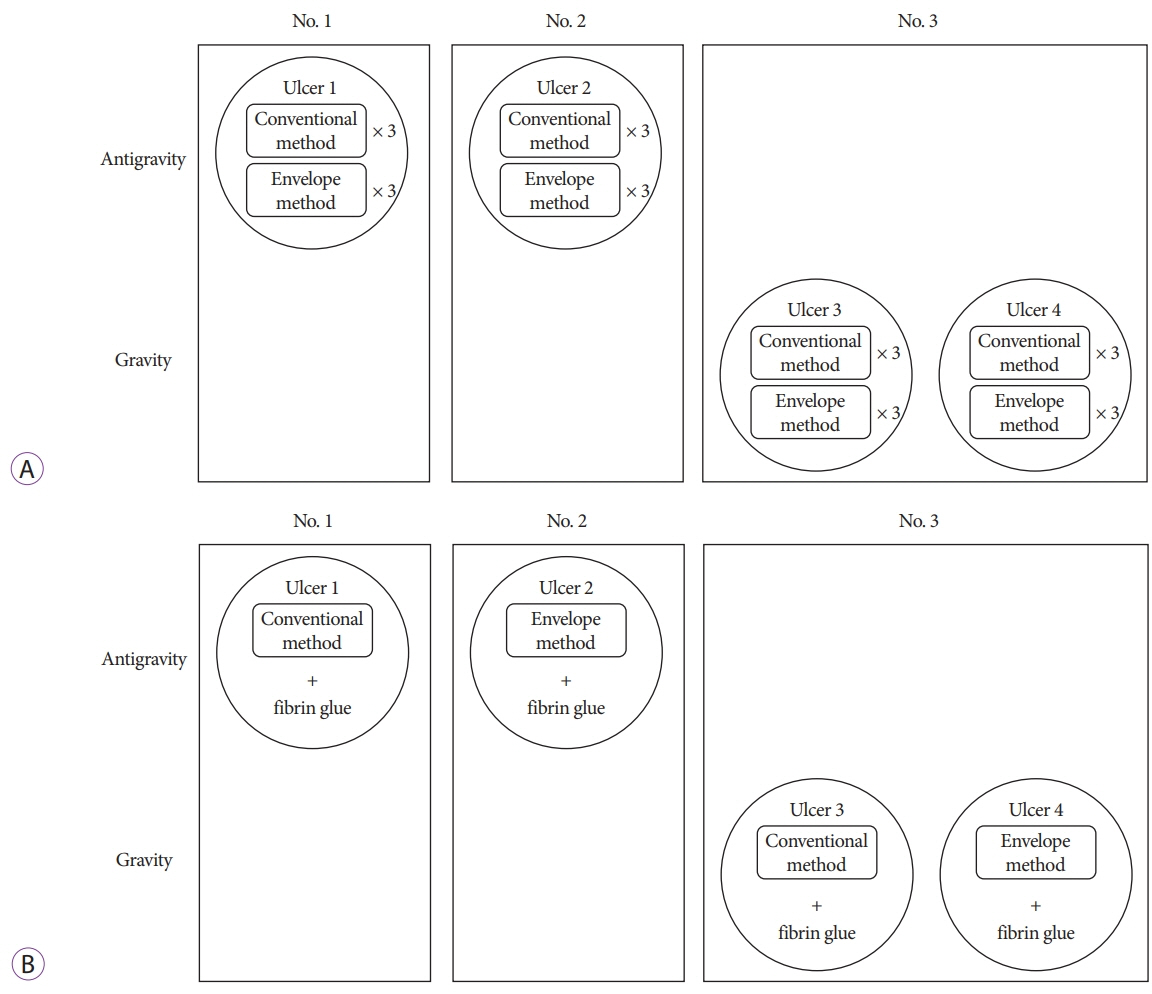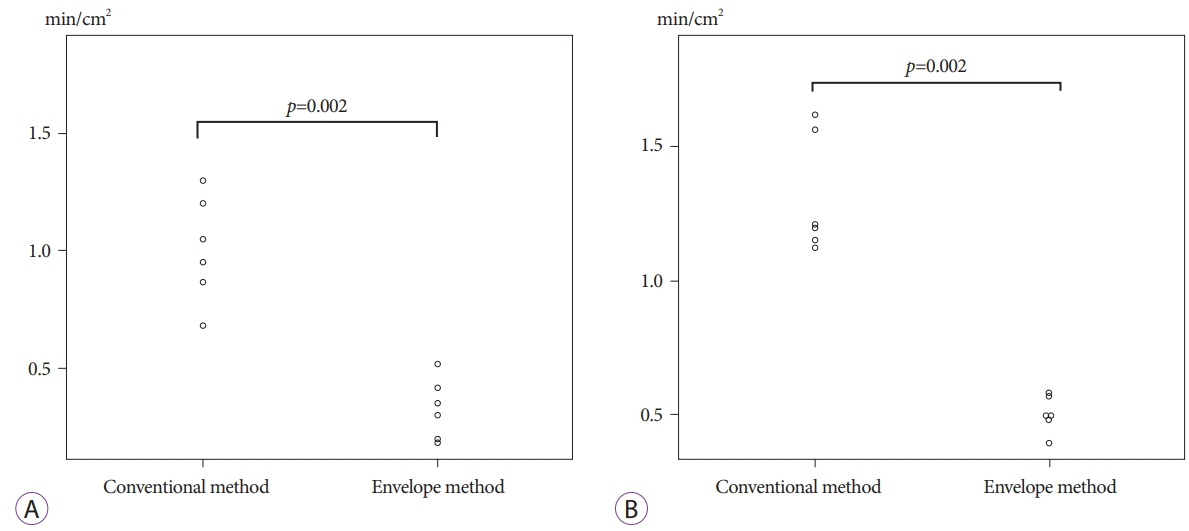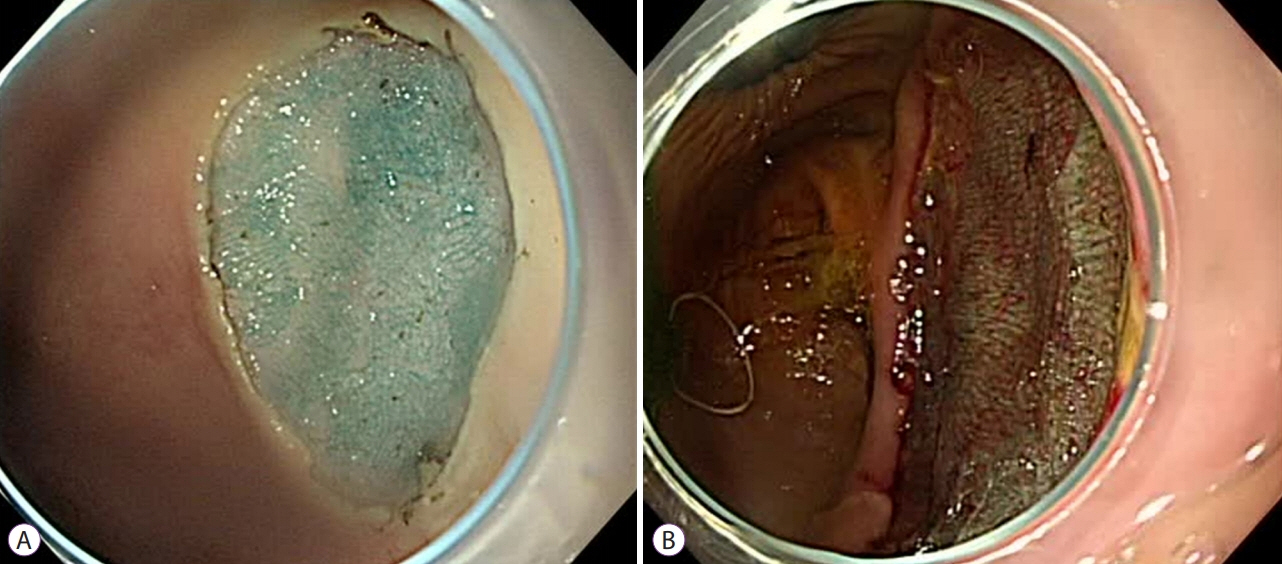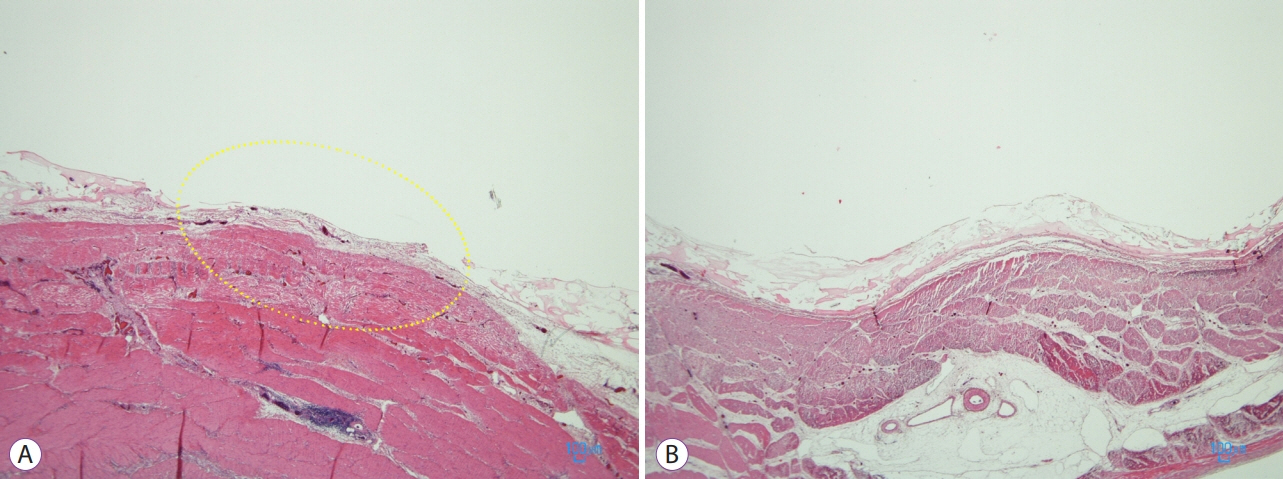Clin Endosc.
2021 Jan;54(1):64-72. 10.5946/ce.2020.014.
Efficacy of the Envelope Method in Applying Polyglycolic Acid Sheets to Post-Endoscopic Submucosal Dissection Ulcers in Living Pigs
- Affiliations
-
- 1Division of Gastroenterology, Department of Internal Medicine, Kobe University Graduate School of Medicine, Kobe, Japan
- 2KM Biologics Co., Ltd., Kumamoto, Japan
- KMID: 2512311
- DOI: http://doi.org/10.5946/ce.2020.014
Abstract
- Background/Aims
Application of polyglycolic acid (PGA) sheets using fibrin glue in post-endoscopic submucosal dissection (ESD) ulcers to prevent bleeding has been reported to be difficult with the conventional delivery method because of gravity. This study assessed the usefulness of the envelope-based delivery system with and against gravity in living pigs.
Methods
PGA sheets were applied on post-ESD ulcers with and against gravity six times each using the conventional and envelope methods, respectively. The PGA sheet delivery time and the endoscopic and histological findings of the treated ulcer floors were compared.
Results
With gravity, the median PGA sheet application time was 1.00 (0.68–1.30) min/cm2 and 0.32 (0.18–0.52) min/cm2 with the conventional and envelope techniques (p=0.002), respectively, and against gravity, it was 1.20 (1.13–1.63) min/cm2 and 0.50 (0.39–0.58) min/cm2 (p=0.002), respectively. Against gravity, the endoscopic and histological findings revealed that the conventional group had insufficient fixation of the PGA sheets, but the envelope groups had sufficient fixation. The results with gravity were similar between the groups.
Conclusions
The envelope method makes it possible to deliver PGA sheets to the stomach quickly and cover ulcers appropriately both with and against gravity in living pigs.
Keyword
Figure
Reference
-
1. Oda I, Suzuki H, Nonaka S, Yoshinaga S. Complications of gastric endoscopic submucosal dissection. Dig Endosc. 2013; 25(Suppl 1):71–78.
Article2. Kataoka Y, Tsuji Y, Sakaguchi Y, et al. Bleeding after endoscopic submucosal dissection: risk factors and preventive methods. World J Gastroenterol. 2016; 22:5927–5935.
Article3. Sato C, Hirasawa K, Koh R, et al. Postoperative bleeding in patients on antithrombotic therapy after gastric endoscopic submucosal dissection. World J Gastroenterol. 2017; 23:5557–5566.
Article4. Oda I, Nonaka S, Abe S, Suzuki H, Yoshinaga S, Saito Y. Is there a need to shield ulcers after endoscopic submucosal dissection in the gastrointestinal tract? Endosc Int Open. 2015; 3:E152–E153.
Article5. Kawata N, Ono H, Takizawa K, et al. Efficacy of polyglycolic acid sheets and fibrin glue for prevention of bleeding after gastric endoscopic submucosal dissection in patients under continued antithrombotic agents. Gastric Cancer. 2018; 21:696–702.
Article6. Fukuda H, Yamaguchi N, Isomoto H, et al. Polyglycolic acid felt sealing method for prevention of bleeding related to endoscopic submucosal dissection in patients taking antithrombotic agents. Gastroenterol Res Pract. 2016; 2016:1457357.
Article7. Iizuka T, Kikuchi D, Hoteya S, Kajiyama Y, Kaise M. Polyglycolic acid sheet and fibrin glue for preventing esophageal stricture after endoscopic submucosal dissection: a historical control study. Dis Esophagus. 2017; 30:1–8.
Article8. Tsuji Y, Fujishiro M, Kodashima S, et al. Polyglycolic acid sheets and fibrin glue decrease the risk of bleeding after endoscopic submucosal dissection of gastric neoplasms (with video). Gastrointest Endosc. 2015; 81:906–912.
Article9. Takeuchi J, Suzuki H, Murata M, et al. Clinical evaluation of application of polyglycolic acid sheet and fibrin glue spray for partial glossectomy. J Oral Maxillofac Surg. 2013; 71:e126–e131.
Article10. Kawai H, Harada K, Ohta H, Tokushima T, Oka S. Prevention of alveolar air leakage after video-assisted thoracic surgery: comparison of the efficacy of methods involving the use of fibrin glue. Thorac Cardiovasc Surg. 2012; 60:351–355.
Article11. Hayashibe A, Sakamoto K, Shinbo M, Makimoto S, Nakamoto T. New method for prevention of bile leakage after hepatic resection. J Surg Oncol. 2006; 94:57–60.
Article12. Sugawara T, Itoh Y, Hirano Y, et al. Novel dural closure technique using polyglactin acid sheet prevents cerebrospinal fluid leakage after spinal surgery. Neurosurgery. 2005; 57(4 Suppl):290–294. discussion 290-294.
Article13. Takimoto K, Toyonaga T, Matsuyama K. Endoscopic tissue shielding to prevent delayed perforation associated with endoscopic submucosal dissection for duodenal neoplasms. Endoscopy. 2012; 44(Suppl 2):E414–E415.
Article14. Takegawa Y, Takao T, Ono H. [Fundamental examination into the use of fibrin glue and polyglycolic acid sheets as a method for covering postESD ulcers]. Gastroenterological Endoscopy. 2015; 57:1150–1157.15. Takao T, Takegawa Y, Ono H, et al. A novel and effective delivery method for polyglycolic acid sheets to post-endoscopic submucosal dissection ulcers. Endoscopy. 2017; 49:359–364.
Article16. Kanda Y. Investigation of the freely available easy-to-use software ‘EZR’ for medical statistics. Bone Marrow Transplant. 2013; 48:452–458.
Article17. Tsuji Y, Ohata K, Gunji T, et al. Endoscopic tissue shielding method with polyglycolic acid sheets and fibrin glue to cover wounds after colorectal endoscopic submucosal dissection (with video). Gastrointest Endosc. 2014; 79:151–155.
Article18. Doyama H, Tominaga K, Yoshida N, Takemura K, Yamada S. Endoscopic tissue shielding with polyglycolic acid sheets, fibrin glue and clips to prevent delayed perforation after duodenal endoscopic resection. Dig Endosc. 2014; 26(Suppl 2):41–45.
Article19. Takao T, Takegawa Y, Shinya N, Tsudomi K, Oka S, Ono H. Tissue shielding with polyglycolic acid sheets and fibrin glue on ulcers induced by endoscopic submucosal dissection in a porcine model. Endosc Int Open. 2015; 3:E146–E151.
Article20. Sakaguchi Y, Tsuji Y, Ono S, et al. Polyglycolic acid sheets with fibrin glue can prevent esophageal stricture after endoscopic submucosal dissection. Endoscopy. 2015; 47:336–340.
Article21. Kumagai K, Iwamoto S, Esaka N, Mizumoto Y. A new method of polyglycolic acid sheet placement in the stomach after endoscopic submucosal dissection. Endoscopy. 2016; 48(Suppl 1):E274–E275.
Article22. Mori H, Guan Y, Kobara H, et al. Efficacy of innovative polyglycolic acid sheet device delivery station system: a randomized prospective study. Surg Endosc. 2018; 32:3076–3086.
Article
- Full Text Links
- Actions
-
Cited
- CITED
-
- Close
- Share
- Similar articles
-
- Endoscopic Management of Gastrointestinal Leaks and Perforation with Polyglycolic Acid Sheets
- Esophageal Stricture Prevention after Endoscopic Submucosal Dissection
- History and Development of Accessories for Endoscopic Submucosal Dissection
- Debates on Colorectal Endoscopic Submucosal Dissection - Traction for Effective Dissection: Gravity Is Enough
- Strategies that Reduce Post-endoscopic Submucosal Dissection Bleeding

